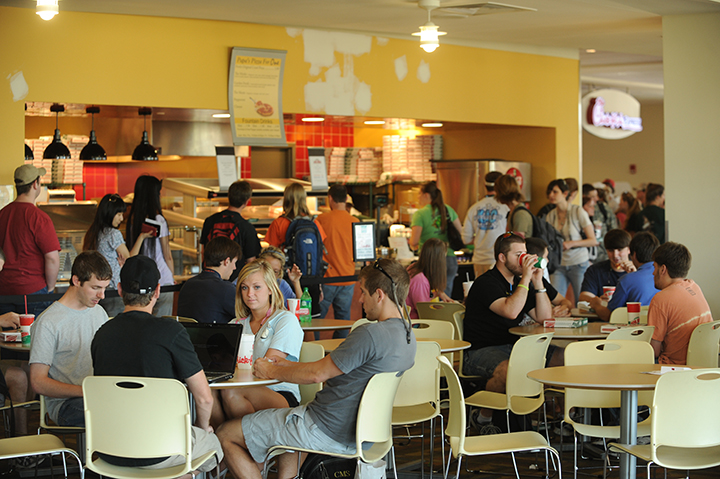 Location and food quality drive students to some on-campus dining options at Auburn
University. Wait times, however, drive some away. Many students want more hamburgers
and less chicken. Females, however, want healthier options, but they also tend the
snack more.
Location and food quality drive students to some on-campus dining options at Auburn
University. Wait times, however, drive some away. Many students want more hamburgers
and less chicken. Females, however, want healthier options, but they also tend the
snack more.
Students in Dora Bock’s marketing research and analytics class shared these and other findings about where
students are eating at Auburn and what attracts them to eat at different dining locations
to help Tiger Dining better serve their needs. The semester-long project included focus groups
and surveys of more than 500 students.
On Friday, April 29, the class shared its data with Glenn Loughridge, Director of Auburn University Campus Dining, which offers students nearly 40 on-campus
dining options, features popular chain venues like Chick-fil-A, Starbucks, Papa John’s,
and Chicken Salad Chick. Tiger Dining recently opened the nation’s first on-campus
gluten-free restaurant, Plains2Plate, located at Lupton Hall.
 “The students did an excellent job presenting the information in an understandable
format and were at their best when we did the question and answer at the end,” Loughridge
said. “I would say they provided more usable data than expected and that they did
so in a constructive and collaborative manner.”
“The students did an excellent job presenting the information in an understandable
format and were at their best when we did the question and answer at the end,” Loughridge
said. “I would say they provided more usable data than expected and that they did
so in a constructive and collaborative manner.”
William Sallustro, Resident District Manager for Chartwells, which holds the contracts
for most dining locations at AU, was also at the presentation.
How did the class draw its conclusions? Research, research, research.
“Research is an integral part of marketing, and I was excited to learn real world
skills from this project,” said Kaitlin Robb, a junior from Clemson, S.C. “Being able
to do a project that involved preliminary research, creating a survey, analyzing data,
and presenting to a client is an opportunity that more college students should have.
We were responsible for meeting deadlines, presenting accurate information, and creating
a professional presentation. We were able to see the process from beginning to end,
which means that in the future if I'm ever tasked with a similar project, I will know
what to expect.”
Key to this research were the focus groups, involving more than 120 students from
a variety of locations across campus.
“Focus groups were an integral part of the research process due to the face-to-face
presence we had with the participants,” Hopewell said. “The focus groups provided
valuable insight into the students’ thoughts because they were able to thoughtfully
respond to the various questions we asked. It was also helpful to come back as a class
and identify trends that occurred in multiple focus groups.”
Robb noted that focus groups give respondents an opportunity to “elaborate on their
answers.”
“Sometimes an answer is not so simple -- as yes, no, or even satisfied/unsatisfied,”
she said. “Focus groups also allow researchers to create more surveys and know what
areas to research further.”
Of 529 surveyed respondents, 352 reported that they dine on campus either multiple
times per day or two to three times per week. Taste quality, location and wait time
were the top three reasons why any given restaurant is chosen, according to respondents.
According to the survey, the best way for Tiger Dining to communicate with students,
either the opening of a new restaurant, estimated wait times, or a daily special,
is by the creation of an app, or via Instagram.
“I had always thought that dining trends among students would be obscure and uncorrelated
from student-to-student,” Liz Hopewell, a senior from Oneonta, Ala., said. “Through
this project I learned that there are similar trends among genders and grade classifications
that can go into marketing strategy for Tiger Dining. Some of the trends that I found
most interesting were: seniors disinterest in a new sandwich restaurant, students’
interest in promotional emails, and frequent snacking among females.”
With the project, Bock, assistant professor in marketing at the Harbert College of Business, said her students, “Learned the importance of qualitative and quantitative research
designs and how to develop a survey to reach a client’s objectives.
“They gained critical thinking skills to determine the correct statistical analysis
for a given research objective,” she said.
Loughridge said the information provided will allow Tiger Dining to focus its efforts
best where they are most valuable to students. “Much of what they reported were things
we knew had some bearing on student sentiment, however understanding how those issues
rank in importance will help shape our strategy going forward.”


 Degrees & Programs
Degrees & Programs
 Faculty & Staff
Faculty & Staff
 Career Development
Career Development
 Recruiters & Industry
Recruiters & Industry
 Location and food quality drive students to some on-campus dining options at Auburn
University. Wait times, however, drive some away. Many students want more hamburgers
and less chicken. Females, however, want healthier options, but they also tend the
snack more.
Location and food quality drive students to some on-campus dining options at Auburn
University. Wait times, however, drive some away. Many students want more hamburgers
and less chicken. Females, however, want healthier options, but they also tend the
snack more. “The students did an excellent job presenting the information in an understandable
format and were at their best when we did the question and answer at the end,” Loughridge
said. “I would say they provided more usable data than expected and that they did
so in a constructive and collaborative manner.”
“The students did an excellent job presenting the information in an understandable
format and were at their best when we did the question and answer at the end,” Loughridge
said. “I would say they provided more usable data than expected and that they did
so in a constructive and collaborative manner.”


